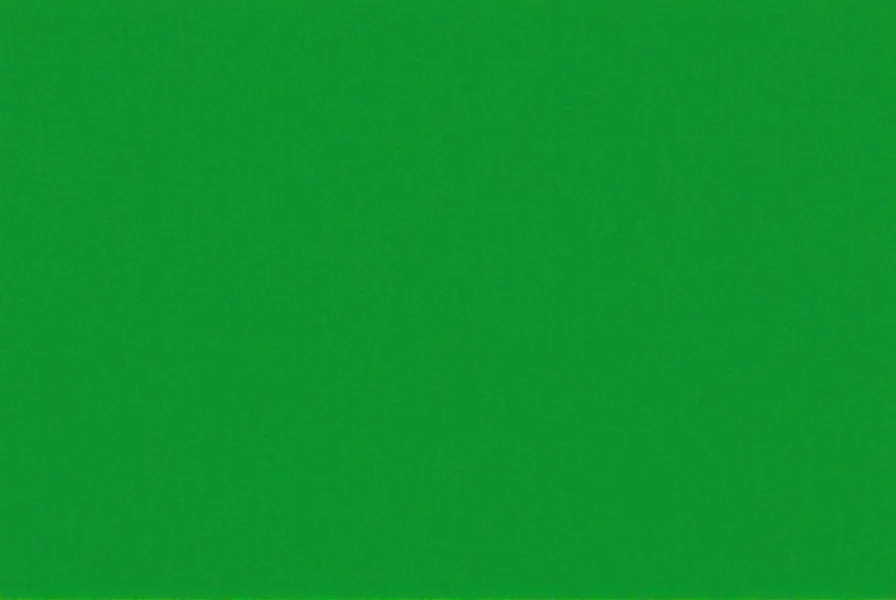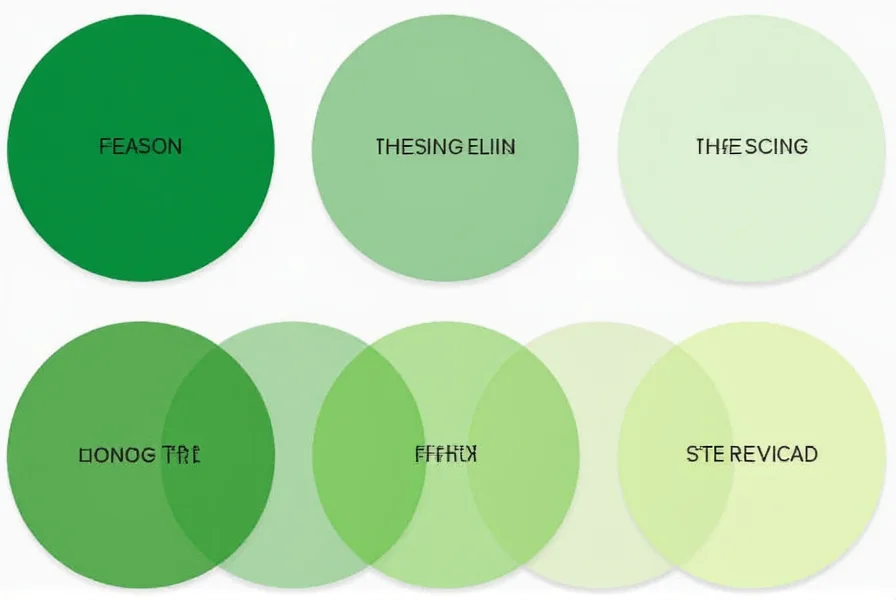Clover green represents one of nature's most recognizable hues, capturing the essence of thriving vegetation. This specific shade sits between yellow-green and true green on the color spectrum, offering a balanced tone that's neither too bright nor too muted. Unlike artificial color formulations, clover green draws its authenticity from the natural world, specifically from the Trifolium genus of plants that blanket fields and lawns across temperate regions.
Natural Origins of Clover Green
The color takes its name directly from the common clover plant, particularly white clover (Trifolium repens) and red clover (Trifolium pratense), whose leaves display this distinctive green when healthy and sun-exposed. During spring and early summer, clover reaches peak vibrancy, creating the visual reference that color scientists and designers use when defining this specific shade. Environmental factors like soil quality, moisture levels, and sunlight exposure affect the precise hue, making clover green slightly variable in nature but consistently recognizable.
Technical Color Specifications
| Color Format | Value |
|---|---|
| Hex Code | #38953C |
| RGB Values | 56, 149, 60 |
| CMYK Values | 63, 0, 58, 42 |
| HSL Values | 123°, 45%, 40% |
These precise measurements allow designers to consistently reproduce clover green across digital and print media. The hex code #38953C serves as the standard digital representation, while the RGB values (56, 149, 60) define how computer monitors display this color. For print applications, the CMYK values (63, 0, 58, 42) ensure accurate reproduction on physical materials.

Clover Green in Color Psychology
This particular shade of green carries significant psychological associations that make it valuable in various applications. Clover green represents renewal, balance, and environmental consciousness without being as intense as forest green or as artificial as neon green. Studies in color psychology show that medium greens like clover green reduce eye strain while promoting feelings of calm and focus—making it an excellent choice for workspaces and healthcare environments.
Unlike brighter greens that can feel energetic to the point of being overwhelming, clover green maintains a soothing quality while still conveying vitality. Its connection to plant life creates subconscious associations with growth, health, and natural abundance. When used in branding, clover green often communicates sustainability and organic values without appearing preachy or artificial.
Comparing Clover Green to Similar Shades
Understanding how clover green differs from other green variations helps in proper application:
- Forest green (#228B22) is darker and more blue-leaning, evoking deep woods rather than fresh foliage
- Mint green (#98FF98) contains more white and blue, creating a cooler, lighter tone associated with freshness
- Emerald green (#50C878) has higher saturation and a jewel-toned quality that feels more luxurious
- Olive green (#808000) incorporates yellow and gray tones for a more muted, earthy appearance
Clover green occupies a sweet spot between these variations—more vibrant than olive, less intense than emerald, and more natural-looking than mint. This versatility explains its growing popularity in contemporary design applications.
Practical Applications Across Industries
Designers leverage clover green's balanced properties across multiple fields:
In interior design, clover green works exceptionally well in spaces where relaxation and focus must coexist, such as home offices, reading nooks, and healthcare facilities. When paired with natural wood tones and cream accents, it creates environments that feel both refreshing and grounded. The color performs particularly well in north-facing rooms that need warming without becoming overwhelming.
Fashion designers increasingly incorporate clover green into seasonal collections, especially for spring and summer lines. Its natural association makes it a staple in sustainable and eco-conscious fashion brands. The shade complements a wide range of skin tones and works effectively in both casual and professional wardrobes.
For branding and marketing, companies focused on health, sustainability, and outdoor products find clover green communicates their values authentically. Unlike brighter greens that might feel artificial, clover green's natural origin gives it credibility in eco-friendly markets. It appears frequently in packaging for organic foods, natural skincare products, and environmental organizations.
Seasonal and Cultural Significance
Clover green carries different meanings across seasons and cultures. In Western traditions, it's strongly associated with spring renewal and St. Patrick's Day celebrations, though the traditional "lucky" green tends to be brighter. The natural connection to clover plants gives this shade additional significance in agricultural communities where clover serves as important cover crop.
In color therapy practices, clover green is used to promote emotional balance and reduce anxiety. Its position in the middle of the green spectrum makes it particularly effective for creating harmony between the stimulating properties of yellow-greens and the calming effects of blue-greens.
Implementing Clover Green Effectively
When incorporating clover green into design projects, consider these practical guidelines:
- Use as a dominant color in spaces where calm focus is needed, but avoid overwhelming small spaces
- Pair with warm neutrals like beige, cream, or light wood tones for balanced, inviting environments
- Combine with complementary colors like soft coral or terracotta for dynamic contrast
- Use in digital interfaces as an accent color for call-to-action buttons to leverage its natural, trustworthy associations
- Consider lighting conditions—clover green appears more vibrant under natural light than artificial lighting
For those exploring clover green paint colors, test samples on multiple walls as the shade can appear significantly different depending on room orientation and existing furnishings. In digital design, ensure sufficient contrast when using clover green text against background colors to maintain accessibility standards.
What is the exact hex code for clover green?
The standard hex code for clover green is #38953C. This specific code represents the medium-dark green shade that closely matches the color of fresh clover leaves in optimal growing conditions. When working on digital projects, this hex value ensures consistent reproduction across different devices and platforms.
How does clover green differ from forest green?
Clover green (#38953C) is noticeably brighter and contains more yellow undertones than forest green (#228B22). Forest green has a deeper, more blue-leaning quality that evokes mature woodland settings, while clover green captures the vibrant, fresh appearance of new plant growth. Visually, clover green appears more energetic and spring-like, whereas forest green feels more traditional and subdued.
Which colors complement clover green best in design applications?
Clover green pairs exceptionally well with warm neutrals like beige, cream, and light wood tones for balanced, natural-looking combinations. For more dynamic pairings, it works beautifully with soft coral, terracotta, or mustard yellow. When seeking contrast, consider pairing with its complementary color in the color wheel—approximately a soft coral or peach tone. Avoid pairing with very bright or neon colors that can overwhelm clover green's natural, grounded quality.
Why is clover green considered an effective color for workspaces?
Clover green promotes focus while reducing eye strain, making it ideal for workspaces. Research in environmental psychology shows that medium greens like clover green create a calming yet stimulating environment that enhances concentration without causing fatigue. Unlike brighter greens that can be overstimulating, clover green's balanced tone supports sustained attention and mental clarity, explaining its growing popularity in office design and digital interfaces.
How does lighting affect the appearance of clover green?
Lighting significantly impacts how clover green appears in physical spaces. Under natural daylight, especially morning light, clover green displays its full vibrant quality with noticeable yellow undertones. In artificial lighting, particularly warm incandescent bulbs, it may appear slightly more yellow, while under cool LED lighting, it might take on subtle blue undertones. When selecting clover green for interior applications, always test samples under the actual lighting conditions of the space to ensure the desired effect.











 浙公网安备
33010002000092号
浙公网安备
33010002000092号 浙B2-20120091-4
浙B2-20120091-4